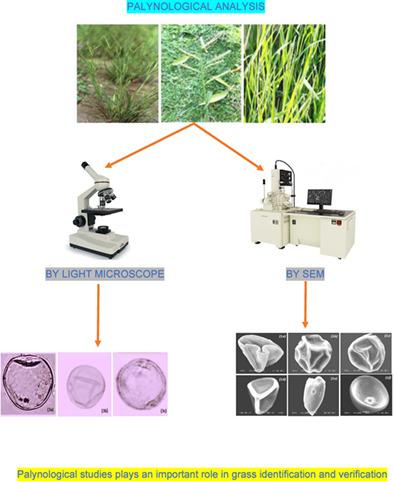当前位置:
X-MOL 学术
›
Microsc. Res. Tech.
›
论文详情
Our official English website, www.x-mol.net, welcomes your
feedback! (Note: you will need to create a separate account there.)
Morphological and palynological assessment of taxonomically problematic genus Paspalum based on light and scanning electron microscopy
Microscopy Research and Technique ( IF 2.0 ) Pub Date : 2021-09-16 , DOI: 10.1002/jemt.23936 Shabnum Shaheen 1 , Muhammad Asaf Khan 2 , Muhammad Naveed Shahid 3 , Zeeshan Shamim 4 , Bilal Rasool 5 , Khadim Hussain 2, 6 , Sana Khalid 1 , Nidaa Harun 7 , Riffat Siddique 1 , Romaisha Sonia 1 , Farah Khan 1
Microscopy Research and Technique ( IF 2.0 ) Pub Date : 2021-09-16 , DOI: 10.1002/jemt.23936 Shabnum Shaheen 1 , Muhammad Asaf Khan 2 , Muhammad Naveed Shahid 3 , Zeeshan Shamim 4 , Bilal Rasool 5 , Khadim Hussain 2, 6 , Sana Khalid 1 , Nidaa Harun 7 , Riffat Siddique 1 , Romaisha Sonia 1 , Farah Khan 1
Affiliation

|
Present research work was carried out to clarify the variations among species of genus Paspalum morphologically and palynologically as this genus is taxonomically difficult due to having multiple similar morphologically overlapping characters which make it difficult to identify. Henceforth present research work was carried out to delimit taxa within the same genus by morphological and palynological tools through light microscopy (LM) and scanning electron microscopy (SEM). Both these tools are considered as the most useful taxonomic characters for taxonomically problematic genera. The results showed a lot of variations among morphological characters. In Paspalum dilatatum, the upper glume was ovate whereas in the other two species, the upper glume was elliptic. The upper glume apex found in P. dilatatum and Paspalum scrobiculatum was obtuse whereas in Paspalum distichum, upper glume apex was acute. Glume nerves showed variation in all three species. Paspalum distichum was 3 nerved, P. scrobiculatum was 5–7 nerved, and P. dilatatum was 5–9 nerved. All three species showed variation in lemma nerves. Paspalum scrobiculatum had 3 nerved lemma whereas in P. distichum 3–5 nerved and P. dilatatum 5–9 nerved lemma were present. In polar and equatorial view, pollen grains ranged from 25 (20–30) to 37.5 (30–45) μm. Paspalum distichum appeared to be the smallest in size whereas P. dilatatum was the largest. Exine thickness ranged from 0.75 (0.5–1) to 1.35 (1.2–1.5) μm. The higher value of pollen fertility was found in P. scrobiculatum as 87.69% and the lowest value was in P. distichum as 78.08%. Morphological keys were also given for correct identification.
中文翻译:

基于光学和扫描电子显微镜的分类问题雀稗属的形态学和孢粉学评估
目前的研究工作是从形态学和孢粉学上阐明雀稗属物种之间的变异,因为该属由于具有多个相似的形态重叠特征而难以识别,因此在分类学上很困难。此后,通过光学显微镜 (LM) 和扫描电子显微镜 (SEM) 的形态学和孢粉学工具,开展了目前的研究工作,以在同一属内划分分类群。这两种工具都被认为是分类问题属最有用的分类特征。结果表明,形态特征之间存在很大差异。在雀稗,上颖片呈卵形,而在其他两个物种中,上颖片呈椭圆形。在P. dilatatum和Paspalum scrobiculatum中发现的上颖片顶端是钝的,而在Paspalum distichum中发现的上颖片顶端是尖锐的。颖片神经在所有三个物种中都表现出差异。Paspalum distichum有 3 个神经,P. scrobiculatum有 5-7 个神经,P. dilatatum有 5-9 个神经。所有三个物种都表现出外稃神经的变异。Paspalum scrobiculatum有 3 个神经外稃,而P. distichum 3-5 个神经外稃和P. dilatatatum存在 5-9 个神经外稃。在极地和赤道视图中,花粉粒的范围从 25 (20-30) 到 37.5 (30-45) μm。Paspalum distichum的大小似乎最小,而P. dilatatum最大。外壁厚度范围为 0.75 (0.5–1) 至 1.35 (1.2–1.5) μm。P. scrobiculatum花粉育性最高,为87.69%,最低为78.08%。还给出了形态键以进行正确识别。
更新日期:2021-09-16
中文翻译:

基于光学和扫描电子显微镜的分类问题雀稗属的形态学和孢粉学评估
目前的研究工作是从形态学和孢粉学上阐明雀稗属物种之间的变异,因为该属由于具有多个相似的形态重叠特征而难以识别,因此在分类学上很困难。此后,通过光学显微镜 (LM) 和扫描电子显微镜 (SEM) 的形态学和孢粉学工具,开展了目前的研究工作,以在同一属内划分分类群。这两种工具都被认为是分类问题属最有用的分类特征。结果表明,形态特征之间存在很大差异。在雀稗,上颖片呈卵形,而在其他两个物种中,上颖片呈椭圆形。在P. dilatatum和Paspalum scrobiculatum中发现的上颖片顶端是钝的,而在Paspalum distichum中发现的上颖片顶端是尖锐的。颖片神经在所有三个物种中都表现出差异。Paspalum distichum有 3 个神经,P. scrobiculatum有 5-7 个神经,P. dilatatum有 5-9 个神经。所有三个物种都表现出外稃神经的变异。Paspalum scrobiculatum有 3 个神经外稃,而P. distichum 3-5 个神经外稃和P. dilatatatum存在 5-9 个神经外稃。在极地和赤道视图中,花粉粒的范围从 25 (20-30) 到 37.5 (30-45) μm。Paspalum distichum的大小似乎最小,而P. dilatatum最大。外壁厚度范围为 0.75 (0.5–1) 至 1.35 (1.2–1.5) μm。P. scrobiculatum花粉育性最高,为87.69%,最低为78.08%。还给出了形态键以进行正确识别。











































 京公网安备 11010802027423号
京公网安备 11010802027423号